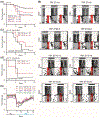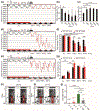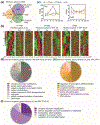Impaired function of the suprachiasmatic nucleus rescues the loss of body temperature homeostasis caused by time-restricted feeding
- PMID: 32864176
- PMCID: PMC7455017
- DOI: 10.1016/j.scib.2020.03.025
Impaired function of the suprachiasmatic nucleus rescues the loss of body temperature homeostasis caused by time-restricted feeding
Abstract
The suprachiasmatic nucleus (SCN) is the master circadian pacemaker that drives body temperature rhythm. Time-restricted feeding (TRF) has potential as a preventative or therapeutic approach against many diseases. The potential side effects of TRF remain unknown. Here we show that a 4-hour TRF stimulus in mice can severely impair body temperature homeostasis and can result in lethality. Nearly half of the mice died at 21 °C, and all mice died at 18 °C during 4-hour TRF. Moreover, this effect was modulated by the circadian clock and was associated with severe hypothermia due to loss of body temperature homeostasis, which is different from "torpor", an adaptive response under food deprivation. Disrupting the circadian clock by the SCN lesions or a non-invasive method (constant light) which disrupts circadian clock rescued lethality during TRF. Analysis of circadian gene expression in the dorsomedial hypothalamus (DMH) demonstrated that TRF reprograms rhythmic transcriptome in DMH and suppresses expression of genes, such as Ccr5 and Calcrl, which are involved in thermoregulation. We demonstrate a side effect of 4-hour TRF on the homeostasis of body temperature and a rescue function by impairing the SCN function. Altogether, our results suggested that constructing a circadian arrhythmicity may have a beneficial effect on the host response to an acute stress.
Keywords: Body temperature; Circadian Clock; Hypothermia; The dorsomedial hypothalamus; The suprachiasmatic nucleus; Time-restricted feeding.
Conflict of interest statement
Conflict of interest The authors declare that they have no conflict of interest
Figures






References
-
- Shigeyoshi Y, Taguchi K, Yamamoto S, et al. Light-induced resetting of a mammalian circadian clock is associated with rapid induction of the mper1 transcript. Cell, 1997, 91: 1043–1053 - PubMed
-
- Okamura H, Miyake S, Sumi Y, et al. Photic induction of mper1 and mper2 in cry-deficient mice lacking a biological clock. Science, 1999, 286: 2531–2534 - PubMed
Grants and funding
LinkOut - more resources
Full Text Sources
Molecular Biology Databases

